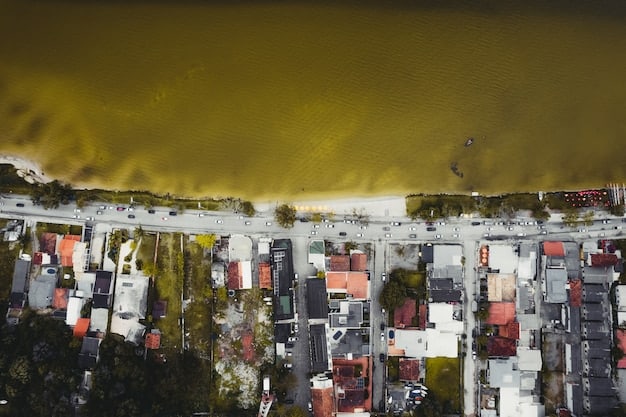Understanding the Financial Impact of Natural Disasters: Aid and Insurance Options

The Financial Impact of Natural Disasters: Understanding Federal Aid and Insurance Options examines the economic consequences of natural disasters on individuals and communities, exploring available federal assistance programs and insurance solutions to mitigate losses and facilitate recovery.
Natural disasters can unleash devastating financial burdens on individuals and communities. Understanding the financial impact of natural disasters, encompassing both the potential losses and the available support through federal aid and insurance options, is crucial for resilience and recovery.
Understanding the Economic Impact of Natural Disasters
Natural disasters, ranging from hurricanes and floods to wildfires and earthquakes, inflict a substantial economic toll on individuals, businesses, and communities. These events can lead to property damage, business disruptions, and significant financial losses, impacting both short-term and long-term economic stability. Understanding the multifaceted economic consequences is the first step in preparing for and mitigating their impact.
Direct and Indirect Costs
The economic impact of natural disasters can be broadly categorized into direct and indirect costs. Direct costs include the immediate expenses associated with the disaster, such as property damage, infrastructure repairs, and emergency response efforts. Indirect costs, on the other hand, encompass the long-term economic consequences, such as business interruptions, reduced productivity, and decreased property values.
- Property Damage: Natural disasters can cause extensive damage to homes, businesses, and public infrastructure, leading to significant financial losses for property owners and communities.
- Business Interruption: Disasters can disrupt business operations, leading to lost revenue, supply chain disruptions, and unemployment.
- Reduced Productivity: The physical and emotional toll of disasters can reduce productivity among individuals and communities, impacting economic output.
Furthermore, the costs associated with natural disasters extend beyond immediate financial losses. They can also include increased healthcare expenses, mental health services, and the costs of relocating displaced individuals and families.
In conclusion, understanding the breadth and depth of the economic impact of natural disasters is crucial for developing effective strategies for preparedness, mitigation, and recovery. This understanding enables individuals, businesses, and communities to make informed decisions about insurance coverage, emergency planning, and resource allocation.
Navigating Federal Disaster Assistance Programs
When natural disasters strike, the federal government offers a range of assistance programs designed to help individuals, families, and communities recover. These programs provide financial aid, resources, and support for various needs, from housing and food assistance to business loans and disaster unemployment benefits. Navigating these programs effectively requires understanding their eligibility criteria, application processes, and available benefits.
FEMA’s Individual Assistance Program
The Federal Emergency Management Agency (FEMA) offers Individual Assistance (IA) programs to eligible individuals and households affected by a disaster. These programs include:
- Housing Assistance: Provides financial assistance for temporary housing, home repairs, and replacement of damaged property.
- Other Needs Assistance: Offers financial assistance for essential needs like medical expenses, childcare, and funeral costs.
- Disaster Unemployment Assistance: Provides unemployment benefits to individuals who lost their jobs due to the disaster but are not eligible for regular unemployment insurance.
To apply for FEMA assistance, individuals must register online at DisasterAssistance.gov or call the FEMA helpline.

SBA Disaster Loans
The Small Business Administration (SBA) offers disaster loans to businesses, private non-profit organizations, and homeowners affected by a disaster. These loans can be used to repair or replace damaged property, equipment, and inventory. The SBA offers two types of disaster loans:
- Physical Disaster Loans: Provide financial assistance to repair or replace damaged property, including real estate, equipment, and inventory.
- Economic Injury Disaster Loans: Help small businesses and non-profit organizations meet their financial obligations when they are unable to operate due to a disaster.
For many facing the aftermath of a natural disaster, federal assistance is essential for bridging the gap between immediate needs and long-term recovery. By understanding the available programs and navigating the application processes effectively, individuals and communities can access the resources necessary to rebuild their lives and livelihoods.
The Role of Insurance in Disaster Recovery
Insurance plays a critical role in mitigating the financial impact of natural disasters. Having adequate insurance coverage can provide individuals and businesses with the financial resources to repair or replace damaged property, cover business interruption losses, and manage other disaster-related expenses. Understanding different types of insurance and their coverage limitations is essential for protecting your assets against potential losses.
Homeowners Insurance
Homeowners insurance provides coverage for damage to your home and personal property caused by various perils, such as fire, wind, and theft. However, most standard homeowners insurance policies do not cover flood or earthquake damage. Separate flood insurance and earthquake insurance policies are typically required to protect against these specific risks.
Flood Insurance
Flood insurance is essential for homeowners and businesses located in flood-prone areas. The National Flood Insurance Program (NFIP) offers flood insurance policies to homeowners, renters, and business owners in participating communities. Flood insurance can cover damage to your building and its contents caused by flooding.

Business Interruption Insurance
Business interruption insurance can help businesses recover from financial losses caused by a temporary shutdown due to a covered peril. This type of insurance can cover lost profits, operating expenses, and other costs incurred during the period of interruption.
In conclusion, understanding the different types of insurance and their coverage limitations is essential for protecting your assets and mitigating the financial impact of natural disasters. Review your insurance policies regularly to ensure that you have adequate coverage for your specific needs and risks.
Strategies for Financial Preparedness Before a Disaster
While federal aid and insurance can provide crucial support after a disaster, proactive financial preparedness is essential for minimizing potential losses and ensuring a more secure recovery. Implementing strategies for building an emergency fund, securing important documents, and creating a financial recovery plan can significantly enhance your resilience in the face of natural disasters.
Building an Emergency Fund
An emergency fund can provide a financial cushion to cover unexpected expenses and lost income in the aftermath of a disaster. Aim to save at least three to six months’ worth of living expenses in a readily accessible savings account.
Securing Important Documents
Protecting important documents, such as insurance policies, financial records, and identification documents, is crucial for accessing assistance and managing your finances after a disaster. Store these documents in a waterproof and fireproof container or digitally back them up in a secure cloud storage location.
Creating a Financial Recovery Plan
Developing a financial recovery plan can help you prioritize expenses, manage debt, and access resources in the aftermath of a disaster. This plan should outline your income and expenses, identify potential sources of financial assistance, and include strategies for rebuilding your credit.
By taking proactive steps to prepare financially for natural disasters, you can minimize potential losses, enhance your resilience, and ensure a smoother recovery process. These strategies, combined with adequate insurance coverage and awareness of federal assistance programs, can provide a comprehensive approach to disaster preparedness.
Understanding the Application Process for Federal Aid
Navigating the application process for federal aid can be complex, but understanding the key steps and requirements can increase your chances of receiving assistance. Gathering necessary documentation, meeting eligibility criteria, and following application deadlines are crucial for a successful outcome.
Gathering Necessary Documentation
When applying for federal aid, it’s essential to have the necessary documentation readily available. This documentation may include:
- Proof of identity (driver’s license, passport)
- Proof of residency (utility bill, lease agreement)
- Insurance policy information
Meeting Eligibility Criteria
Each federal aid program has specific eligibility criteria that applicants must meet. These criteria may include income limits, residency requirements, and the extent of damage caused by the disaster. Review the eligibility requirements carefully before applying.
Following Application Deadlines
Each federal aid program has specific application deadlines that applicants must adhere to. These deadlines are typically set by FEMA or other administering agencies. Missing the application deadline can result in denial of assistance.
In conclusion, understanding the application process for federal aid and taking the necessary steps to prepare and apply can significantly increase your chances of receiving assistance. Gathering documentation, meeting eligibility criteria, and following application deadlines are essential for a successful outcome.
Long-Term Financial Recovery Strategies
Recovering financially from a natural disaster is a long-term process that requires careful planning, resource management, and access to appropriate support services. Developing strategies for rebuilding credit, managing debt, and accessing financial counseling can help individuals and communities regain financial stability and build a more secure future.
Rebuilding Credit
A natural disaster can negatively impact your credit score due to missed payments, increased debt, and potential job loss. Rebuilding your credit requires:
- Paying bills on time: Make timely payments on all your debts, even if it means making minimum payments.
- Managing debt: Develop a plan to manage your debt and prioritize payments to avoid accumulating further interest and fees.
- Checking your credit report: Regularly review your credit report for inaccuracies and dispute any errors you find.
Managing Debt
Managing debt is crucial for long-term financial recovery. Consider options such as:
- Debt consolidation: Combine multiple debts into a single loan with a lower interest rate.
- Debt management plan: Work with a credit counseling agency to develop a debt management plan and negotiate with creditors.
- Bankruptcy: Consider bankruptcy as a last resort if you are unable to manage your debt through other means.
Accessing Financial Counseling
Financial counseling can provide you with the guidance and support you need to navigate the financial challenges of disaster recovery. Counselors can help you develop a budget, manage debt, rebuild credit, and access financial resources.
The road to financial recovery after a natural disaster can be challenging, but with careful planning, resource management, and access to appropriate support services, individuals and communities can regain financial stability and build a more secure future. By implementing strategies for rebuilding credit, managing debt, and accessing financial counseling, you can take control of your finances and build a foundation for long-term financial well-being.
| Key Topic | Brief Description |
|---|---|
| 🏠 Property Damage | Natural disasters often lead to significant property damage, affecting homes and infrastructure. |
| 🏢 Business Interruption | Disasters can disrupt business operations, causing revenue loss and supply chain issues. |
| 💰 Federal Aid | Programs like FEMA and SBA offer financial aid for housing, business, and unemployment. |
| ☂️ Insurance Options | Homeowners, flood, and business interruption insurance can mitigate financial losses. |
Frequently Asked Questions (FAQ)
▼
FEMA’s Individual Assistance program typically covers major disasters such as hurricanes, floods, wildfires, and earthquakes. Eligibility depends on the severity and impact of the disaster as declared by the President.
▼
You can apply for an SBA disaster loan online through the SBA’s website or in person at a Disaster Recovery Center. The process involves submitting an application with detailed information about your losses and financial situation.
▼
Homeowners insurance typically covers damages from events like fire, wind, and theft, but it generally doesn’t cover floods. Flood insurance, on the other hand, specifically covers damages caused by flooding, usually obtained through the NFIP.
▼
To prepare financially, build an emergency fund, secure essential documents in a safe location, review and update insurance policies, and create a financial recovery plan. These steps can help minimize the financial impact of a disaster.
▼
Long-term strategies include rebuilding credit by paying bills on time, managing debt through consolidation or counseling, and seeking professional financial advice to navigate the complexities of recovery after a natural disaster.
Conclusion
Understanding the financial impact of natural disasters and exploring available federal aid and insurance options is crucial for securing your future. Taking proactive steps to prepare financially, understanding available resources, and developing a long-term recovery plan can significantly reduce the financial strain caused by these devastating events.





